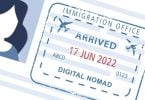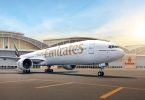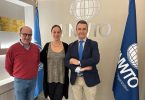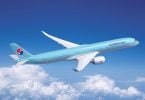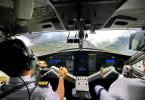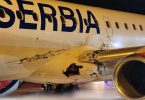Chaos Theory
Chaos is a term used to describe the world when nothing makes sense; when 2+2 does not equal 4, leaving us completely and totally confused. Sometimes the “butterfly effect” is used to explain the phenomenon: the idea is that the flapping of a butterfly’s wings in Argentina could cause a tornado in Texas three weeks later. Perhaps, at this moment, it is better to look at Aristotle and his theory of “sensitive dependence” where he observed that, “the least initial deviation from the truth is multiplied later a thousandfold” (Aristotle OTH, 271b8).
Unfortunately, we are living in a universe where lies and half-truths have been normalized; what we accepted as rational and real yesterday, no longer brings the same results; what we did to create an equilibrium in our professional and personal lives no longer brings satisfactory or rewarding results.
Pre-disaster Preparedness
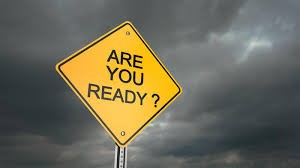
The hotel, travel and tourism industry has been criticized for being unprepared for this crises and economic disaster. It does appear that business and government leaders as well as politicians were not in a state of readiness with responses that would have mitigated the impact of the COVID-19 event as it evolved.
Some suggest that risk assessments should be part of the managerial process and based on scenario analysis, contingency plans developed in accordance with situations considered likely to occur. This is an excellent theory; however, with the exception of certain events, i.e., hurricanes in the Caribbean, tourism crises are unpredictable in their occurrence, evolution and impact. Although broad categories of crises, such as terrorist attacks, might be anticipated and established protocols put in place, in reality, crises and disasters occur without warning and require a rapid reaction.
Hovering on the Edge of Disorder
Instability and change are a characteristic part of the tourism industry. Even if there is constancy and equilibrium over a period of time, this balance is always tenuous. There is an ever-present danger of disruption. Folding back on the “butterfly effect,” in the industry, an apparently trivial incident may initiate a set of events leading to a major crisis. For example, the ash cloud from the Eyjafjallajökull eruption in Iceland (2010), not only impacted on the global aviation industry, it caused significant disruption for individuals and businesses around the world dependent on international aviation. If we consider the trajectory of COVID-19 – from one incident in China that was observed but not considered important, has led to a pandemic and global economic crisis.
Central to chaos theory is that order will emerge from a chaotic state; however, there is a need for an “island of stability” to exist during the prevailing chaos. In some cases, it is government agencies such as the National Guard and FEMA. There is a need for a common sense of meaning, strategy or value system that drives people to achieve a common goal. Since the inception of COVID-19 – there has been no agency, organization or person able to provide the steady, guiding hand necessary to lead the industry to problem resolution and a new beginning. The world has had to face the virus and economic collapse through quarantine and isolation, relying on social media and television news casts for information, which is often clouded by lies, half-truths and self-serving hyperbole.
Airline Chaos
The cliché for the adversity that envelopes a large part of the universe suggests that “we are all in this together.” This is not even close to the truth (at a time when truth is at a premium price). The airline industry is playing brinkmanship with their passengers, employees, government agencies and banks. The industry spends huge amounts of money promoting the idea that flying is safe while data shows that passengers are being infected by COVID-19, getting sick and facing long term illness and/or death. The Center for Disease Control (CDC) stated, “We conclude that the risk for on-board transmission of SARS-CoV-2 during long flights is real and has the potential to cause COVID-19 clusters of substantial size, even in business class-like setting with spacious seating arrangements well beyond the established distance used to define close contact on airplanes.”
The Center for Infectious Disease Research and Policy (CIDRAP) (September 21, 2020) cited three studies describing in-flight COVID-19 transmission with one involving a single symptomatic passenger who likely infected at least 12 others during an international flight.
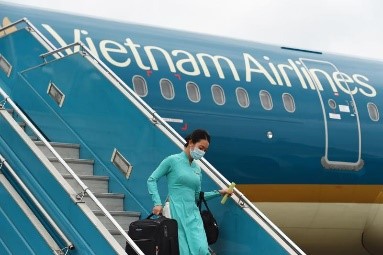
One study, published in Emerging Infectious Diseases, reviewed a 10-hour Vietnam Airlines flight from London to Hanoi, Vietnam on March 1 that resulted in 15 ill people in addition to the index patient, creating an attack rate of 62 percent on a 274 -seat plane. Of the 12 infected passengers in business class, 8 (67 percent) developed symptoms after a median of 8.8 days following arrival in Hanoi. CIDRAP challenges the findings of the airline industry, “Transmission on flight VN54 was clustered in business class, where seats are already more widely spaced than in economy class, and infection spread much further than the existing 2-row or 6.6 feet rule recommended for COVID-19 prevention in airplane and other public transport would have captured” ( https://www.cidrap.umn.edu/ ). On October 20, 2020, Rachel DeSantis reported the July 25, 2020 COVID-19 death of a Texas woman (in her 30s), who died on the plane as it sat on the tarmac waiting for take-off.
The TSA reports that 271 employees have been identified with active COVID-19 infections. Since the beginning of the pandemic, 2,204 federal employees tested positive and 8 employees and 1 screening contractor has died from the virus (tsa.gov/coronavirus).
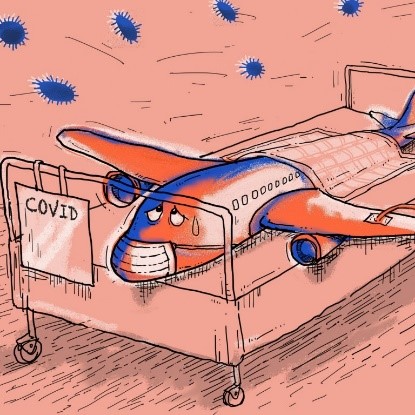
According to McKinsey.com, airline revenue has decreased and 2/3 of the world’s aircraft fleet has been parked with 18 airlines filing for bankruptcy in the last few months. On a global basis, it is estimated the industry will lose $315 billion in passenger revenue in 2020. Only three airlines, China Airlines, Korean Air and Asiana Airlines have reported profits in the second quarter due to their reliance on cargo.
When compared with the prior year, Delta’s adjusted Q2 revenue declined 91 percent as system capacity dropped by 85 percent. United Airlines reported the company was losing $40 million cash per day. Lufthansa registered a year-over-year revenue slump of 89 percent while revenues for Air France/KLM dropped by 82 percent or $6.6 billion compared with the second quarter of 2019.
The airlines have sought government bail-outs and globally the industry has received aid totaling $123 billion. The cash covers approximately 1/5 of 2019 revenues; half of the aid, $67 billion, comes in the form of loans or other liabilities that will be repaid, with interest. Some of the money was to be directed to employees; however, United promised to pay employees through September and then diminish the number of employees. JetBlue took the bailout money but decided not to pay the workers their full salaries, keeping cash for themselves and all JetBlue employees were required to take 24 days of unpaid time between April 20 and September 30, 2020; money earmarked by Congress for employees has been redirected to improving shareholder equity (viewfromthewing.com).
McKinsey does not see global air travel demand recovery until 2024, although it might be led by Asia – Pacific in 2023 with North America and Europe reaching precrisis levels in 2024. An optimistic scenario does not show full air demand recovery before 2022. Short-term, the consumer is likely to benefit with lower prices; long term, due to decreased competition, the need to payback government loans and potential health related operational measures, there are likely to increased ticket prices.
Rooms at the Inn
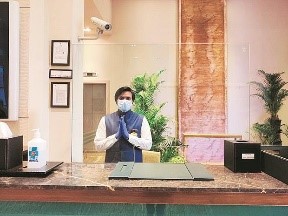
With large numbers of people quarantined, borders locked, and meetings held on Zoom, there has been little reason or opportunity for travelers to make hotel reservations. McKinsey does not think that occupancy levels will reach 2019 levels until 2023 and revenue per available room (REV PAR) will not rebound until 2024. The fastest growing sectors will be economy and leisure resorts and the largest chains. A survey by the American Hotel and Lodging Association (AHLA) found that nine out of ten US hotels had fired or furloughed staff and more than 8000 hotels could be forced to shut their doors, forever. The news outside of the US is definitely better. In London, 80 percent of hotels have reopened while the hotels in Asia have a brighter picture with 86 percent of hotels in Shanghai reopen and 92 percent of Hong Kong hotels have reopened.
Assistant Professor Andria Rusk, a specialist in infectious disease at Florida International University’s College of Public Health and Social Work finds that, “As with any public place, there are transmission risks in hotels. This risk comes from interacting with fomites – what we call objects or surfaces that are likely to carry infection – or with infected people.”
The biggest established risk of transmission is being in close contact with strangers, and primary concerns in a hotel are employees and other guests and all the areas where there is an intersection between all three.
Experts agree that not all people with COVID-19 display symptoms so that there may be interactions between the guest and staffers who are silently spreading the virus. Therefore, it is critical to not interface with any hotel employee who is not wearing a face covering and other personal protective equipment (PPE).
To make the hotel visit even more precarious, shared amenities and common spaces are more dangerous than private hotel rooms. Lobbies can become crowded during a morning rush to check out, even pools and spas can find people in groups. Elevators offer risks as guests are sharing enclosed spaces with restricted air supply. It is important to note that the virus can live on hard, non-porous surfaces for up to three days (including plastic and stainless steel) (New England Journal of Medicine). Even deep cleaning may fail to eliminate the virus from all surfaces. It is even possible that virus particles linger in the air from previous guests as well as linger on surfaces they touched.
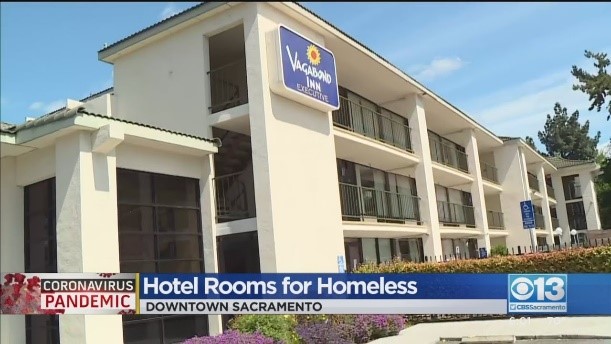
In many cities, hotels and motels are being used for individuals without housing, providing them a safe place to shelter during the coronavirus pandemic. In early April, Governor Gavin Newson (California) launched Project Roomkey with the objective of providing 15,000 hotel and motel rooms for homeless individuals. The rooms were prioritized for those with coronavirus, those who may have been exposed and those who were vulnerable because of their age or health. The program is slated to receive 75 percent reimbursement from the Federal Emergency Management Agency (FEMA) with the rest of the cost paid for by state and local government agencies. Riverside County is being billed $2 million (as of May 2020) with money directed to hotels, food and payment for caseworkers who are responsible for outreach and connect individuals to social services.
This program is a win for hoteliers as they use the program to obtain a cash flow while otherwise being shut down or limited to whom they can serve. When asked to identify the hotels participating in the program, the county and state declined to name the properties, with a nod to respect for the privacy of the people in the voucher program and property safety (Melissa Daniels, April 18, 2020, desertsun.com). The absence of full disclosure as to the name and location of the properties creates a challenge for tourists, uncertain as to the whether the hotel rooms they reserve may be spaces shared with COVID-19 patients.
The pandemic has made hotels dangerous places for employment as well as guests. Wynn Las Vegas has logged almost 500 positive pandemic cases and three deaths among employees since the resort opened in June. Working with the University Medical Center, the company arranged 15,051 tests with the objective of identifying employees positive for the virus but asymptomatic; 548 cases tested positive (a rate of 3.6 percent). Of the total, 51 positive cases were recorded pre-opening and 497 cases were post-opening. Since the hotel opened, six guests have tested positive.
Cliff Diving
All economic indicators validate the harsh reality that the tourism industry has suffered – not because there were errors made by the all sectors of the industry, but rather by ignoring the basic requirement that people in government and private sector leadership positions (elected, appointed and selected) actually have a responsibility to protect citizens, passengers, guests, and employees, regardless of the political persuasions.
A result of the non-response to the pandemic In the United States, is that the tourism industry continues to endure losses, month after month. In October 2020, the USA tourism sector suffered a one-month loss of $41 billion, on par with the losses in September 2020. Travel spending was down 41 percent below the level of 2019 (a $9.1 billion loss). At the beginning of March, COVID-19 was the cause of $415 billion in cumulative losses for the US travel economy. Hawaii, D.C. New York, Massachusetts and Illinois continue to experience losses of over 50 percent. The continued depressed level of travel spending has created a loss of $53.3 billion in federal, state and local tax revenue since March 1, 2020 (ustravel.org/toolkit/covid-19-travel-industry-research).
In August 2020, Alison Durkee (Forbes.com) reported that a United Nations policy brief outlining the pandemic impact on the tourism industry would add up to almost $1 trillion in losses, threatening 100 million jobs worldwide. Losses in the tourism sector were projected to reduce global GDP by 1.4 – 2.8 percent. The slowdown negatively impacts the world’s least developed countries, (i.e., Africa) and small island developing states where tourism accounts for a higher percentage of their GDP, as well as on women and youth who dominate the workforce in tourism
Is There A Plan

Airlines are using financial maneuvering and skewed public relations information to remain viable while hotels have attempted to remain operational by joining with government agencies, providing facilities for people impacted by the virus and quarantine; however, in the long-term, it will be automation technologies, robots and artificial intelligence that will enable facilities to decrease fixed costs and reboot.
It is obvious that decreased demand will shrink enterprises in the tourism sector. The results of this change will include gradual price increases with money directed to enhanced sanitization required by regulations linked to capacity reduction (think social distancing).
Short-term, companies will be flexible in determining price, terms and conditions to alleviate some of the financial risks. Although some pricing strategies will lure customers to flights and hotels, long-term it will do little to alter perceptions (and the need for) safety and security. It is highly likely that the industry will have to change operational activities and marketing, with a focus on enhanced cleaning and sanitizing, the visible use of PPE, and the renovation of premises with a focus on hardwood flooring instead of carpeting. New requirements for airlines and hotels will focus on improved HVAC systems and HEPA filters, new building designs with more open spaces, open windows and separate HVAC systems for rooms and public spaces along with the replacement of people with robots.
In addition:
– Industry participants will shift away from personal interactions to technology thereby limiting contact and possible contagion
– Limits will be placed on the number of people allowed to congregate in public spaces
– New techniques and systems will be designed for preparing and delivering food and beverages
– Room inventory controls will return to the hotel rather than relying on third parties
– Outsourcing of services will provide greater flexibility and limit risks
– Additional and varied insurance policies will reduce the impact of sudden/unexpected hazards.
Light and Tunnels
Confidence that traveling will not cause illness or death will take time to become part of the traveler’s persona. It is up to both the public and private sectors, working together, to rebuild this confidence. Tourists will be placing a higher value on hygiene when selecting their destination, travel, accommodations, dining options and attractions.
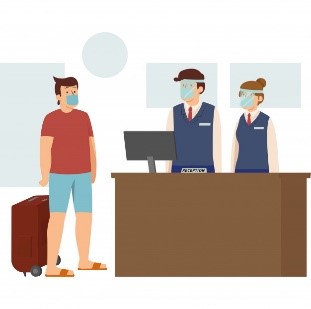
It is all well and good to have attractive employees dancing through the aisles of airlines and the halls of hotels; however, while this might make the owners happy, it is NOT reassuring to the traveler. It will take time to convince the industry leadership that 2019 no longer exists and 2020 is almost over. The new year requires a new mindset, and a new leadership; someone who has yet to emerge.
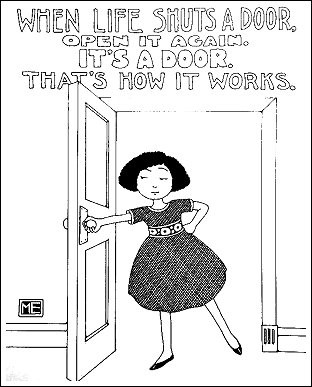
“The test of character is not persistence when you expect a light at the end of the tunnel. The true test is performance and persistence when you see no light coming.” – James Arthur Ray
© Dr. Elinor Garely. This copyright article, including photos, may not be reproduced without written permission from the author.








